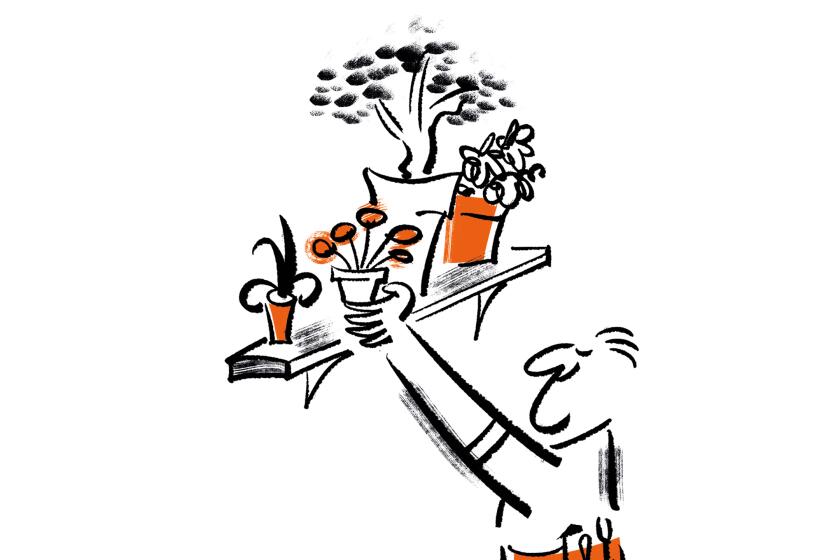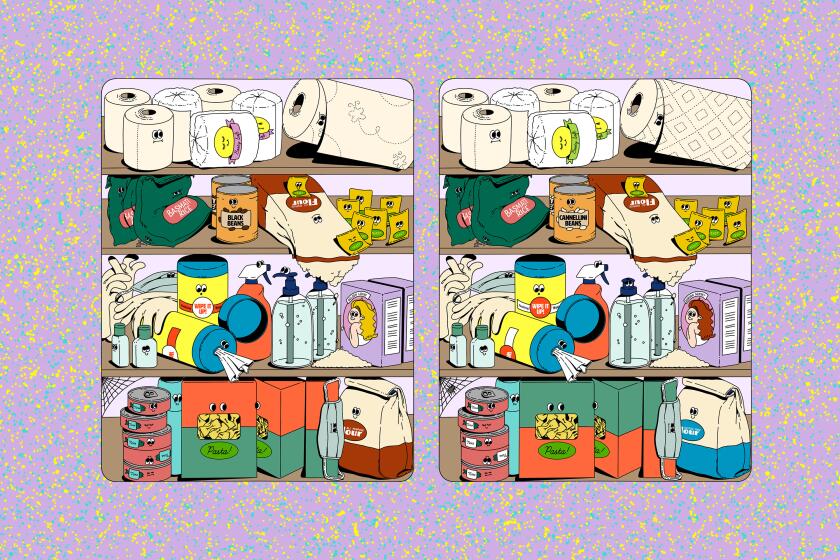This is how I know I’ve been cooped up with downcast distance-learning teens for too long: I spent multiple days dyeing T-shirts and damask napkins with food scraps and foraged plants from my neighborhood.
As sheltering-in-place continues and the days have become indistinguishable, I needed a distraction from my isolated work-from-home routine. I decided to experiment with natural dyes using what I had on hand, and without spending any money.
First, I reached out to Los Angeles-based fiber artist Niki Tsukamoto of Lookout & Wonderland for some tips.
“There are so many things that you can experiment with at home,” Tsukamoto said. “Wild oxalis, avocado pits, onion skins, loquat and eucalyptus leaves all have their own tannins, so they work as a mordant [which bonds color to fabric].”
Tsukamoto went on to explain that part of the fun of experimenting with natural dyes is the transformation process. Colorless avocado pits can produce surprising shades of pink, while onion skins transform water into saturated yellow and orange hues.
“I always talk to people about what it is that they are trying to achieve with their natural dyeing,” said Tsukamoto, who hosts natural dye workshops under normal circumstances. “Are they trying to make something that stays, or fades away in the sun? If you just want to see what happens with different plants, then there are no rules. You can experiment with everything and anything in your kitchen.”
Purple cabbage, for instance, doesn’t have the chemical components to bind to fabric. Still, it’s fun to see what happens.
“The same is true of turmeric, which creates a gorgeous yellow color and has medicinal value,” Tsukamato said. “It doesn’t work as a stable dye but it’s fun to play with. And one of the great things about turmeric is that if you put anything alkaline on it, it will turn red.”
Inspired by Tsukamoto, I attempted to upcycle some old T-shirts and heirloom damask napkins using avocado pits, onion skins and some hot pink hibiscus flowers that I foraged from my neighbor’s yard.
Over several days I collected food scraps, scoured and soaked fabric, and steeped the items in dye baths. My experiments did not go exactly as planned -- my pretty light pink hibiscus dye washed out in the washing machine — but it felt like a brief reprieve from coronavirus lockdown.
Instead of worrying about furlough days and bills, I foraged my neighborhood for hibiscus and bright yellow oxalis.
Instead of wondering if my son will attend college in the fall, I boiled avocado pits and watched as the water turned red.
And instead of losing sleep over what the future holds, I got lost in the process of folding and dyeing napkins using a shibori technique.
You can do it too. Here’s how.
What you’ll need:
4 to 5 fresh and clean avocado pits
Hibiscus flowers
2 pounds onion skins
White vinegar
Cotton, silk, wool or linen fabric
Stainless steel pots (Cooking pans are not recommended)
Rubber bands or hair ties
Small wood squares or cardboard
String, twine or thread
Tongs
Get started
Step 1
Cover onion skins and avocado pits with cold water. Tsukamoto prefers to use reverse osmosis water but any well-filtered water will work. I used tap water because it was readily available. Bring the water to a low boil. Reduce heat and simmer until the water changes color (about an hour). Remove from heat and allow to steep overnight.
I soaked the hibiscus flowers outdoors in the sun all day and left them to steep overnight.
Step 2
Soak your fabric in lukewarm water using 1 part vinegar to 4 parts water for an hour. This creates a natural “mordant,” which helps the dye to bind to the fabric.
Step 3
Add the wet fabric to the dye bath and simmer for 30 to 40 minutes. The longer you simmer the fabric, the darker the colors will be.
I submerged the bottom of my T-shirt in a solar hibiscus dye-bath but after several hours, the dip-dye project produced only slight color. (I should have simmered it on the stove instead.) I soaked the entire T-shirt all day in full sun. (In Sasha Duerr’s book “Natural Color: Vibrant Plant Dye Projects for Your Home and Wardrobe,” she used aluminum sulfate and soda ash in her successful hibiscus dye bath.)
Step 4
To create a shibori pattern, fold the wet fabric back and forth like a paper fan. Fold the long strip into a square and bind it on either side with a clamp. Normally, two small pieces of wood are used as clamps, but I used cardboard because it was all I had. Bind the fabric with string or twine (I used embroidery thread and hair ties) in multiple rows to create a pattern. Soak the bound fabric in the simmering onion dye bath for at least 20 minutes. Remove the square with tongs and rinse in cold water. Remove the ties and cardboard squares and voila — a pattern.
Step 5
Rinse in cold water and hang dry.
Step 6
Your fabric is now ready for machine washing. This is when you will learn if your dye is colorfast. My onion and avocado dyes endured when they came out of the dryer but my subtle pink hibiscus dye evaporated. The colors were unique and varied — the onions produced a deep mustard color and the avocado pits created a soft pink tone.
Now that you know some basics, experiment with beets, carrot tops, purple onions, black beans, rosemary, mandarin orange peels; the possibilities are endless. You can try different mordants and alkalines such as baking soda and lemon juice to change the pH of the dye and shift the color of the fabric.

















